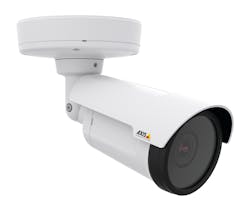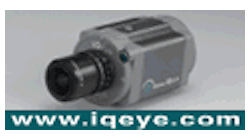4K frenzy: Next-generation of video surveillance tech generating buzz at ISC West
If you thought the battle for high resolution supremacy in the surveillance market was dying down a bit - think again. At this year’s ISC West show in Las Vegas, the industry is abuzz over the introduction of 4K Ultra HD surveillance cameras by a number of different manufacturers. Although the technology itself isn’t new to the market, there have been a number of developments over the past year that makes the adoption of 4K in some applications more feasible.
According to Andres Vigren, product manager for Axis Communications, which made its foray into 4K Ultra HD at the show with the launch of its AXIS P1428-E network camera, the push towards 4K resolution in security is a result of the technology’s progression in consumer electronics.
“It is the consumer market that, I think, is driving 4K,” said Vigren. “A year ago, the cost of 4K monitors was quite high, but today you see monitors for less than $1,000 or, actually, TV sets for less than $1,000. Then people start to say, ‘ok, if I have 4K at home why not in the surveillance industry because people become more aware about the 4K (technology).”
“It was in the broadcast world first, but with technology in the camera business people are like, ‘hey, I have a 16-megapixel camera in my phone, why can’t I get this on the camera?’ People see it elsewhere and it comes into our market because people want that, but at the time, it was so expensive because you have to think past the camera,” explained Wendi Burke, director of global marketing communications for IQinVision, which also debuted a 4K version of its IQeye Sentinel at the show. “Just like that with a full system, you have to have a 4K monitor. Those were anywhere from $3,000 to $6,000 previously. You can be leading-edge, but it has to get to a place where people could actually afford it and use it.”
Both Vigren and Burke said that there are still a lot of things that will have to fall into place before there is widespread adoption of 4K in the industry.
“I don’t think it is all in place yet, but it’s getting there. I think that you still need to make sure that the graphic card is 4K, your computer (network) power is 4K, your monitor is 4K and even your cables have to be specified for the 4K resolution,” said Vigren. “I don’t think everyone has that in place yet. This is something that we will see, in maybe one year’s time that will look much different from today. This is something that is ongoing and this is our first step, so it’s not that we see everything is going to be 4K tomorrow. We still see a big need for 1080p, the 720p cameras as well, but this is just a natural step into the next standard.”
“I think it will take awhile for people to adopt it,” added Burke. “The prices are still coming down. Right now, the camera will be the most expensive piece (of the system). Previously, it was almost like the monitoring equipment would be the most expensive piece, but that’s coming down.”
With that being said, Burke believes that 4K holds a lot of promise for applications throughout the industry.
“For example, in education, a lot of schools in the way the campuses are setup there’s a main school building where all of the infrastructure is which is too far away from all of the sports fields or parking areas and it’s really costly to wire out to those places,” explained Burke. “So, in those situations, you could actually have the camera at the place of infrastructure and still be able to see out to those far reaching areas with enough detail to do what you need to do.”
Kim Loy, chief product officer and VP of global marketing at DVTel, which currently has a 4K camera in beta testing, believes that having a 4K product in the pipeline is important if you want to stay ahead of the technology curve in the industry.
“It’s the latest buzz, so you have to be there to be in the game,” said Loy. “We now have cameras with better resolution than what the human eye can see.”
One problem that Loy thinks could be a hindrance to greater adoption of 4K technology is a lack of attention to the network. Loy said that a lot of integrators and some end users still think that they can install high resolution cameras without making any of the necessary upgrades to network architecture.
John Grabowski, national sales and marketing manager of JVC’s security division, said that they’ve had 4K products within other divisions of the company and that they’re currently working to develop their own 4K surveillance camera.
When asked about the sudden influx of 4K technology to the market, Grabowski said that it needed to mature, which is one of the reasons it is making such a big splash this year. “I think it needed a little time for development,” explained Grabowski. “We decided not to release (our 4K camera) so that we could refine and tweak it.”
Vigren said that 1080p resolution will remain the most viable option for many end users in the near term.
“Looking at a 1080p monitor and a 1080p image, it looks really, really good,” Vigren said. The computer is set for 1080p, everything is set for 1080p and also you have some other benefits with 1080p. You still have better light sensitivity in the lower resolution cameras, so the 1080p is better light sensitivity than you would have in the 4K. There are definitely still benefits with 1080p.”
Arecont Vision, an industry leader in IP megapixel camera technology, was also among those video vendors unveiling a 4K camera solution with its next generation of multi-megapixel imaging. The company's new MegaVideo 4K (3,840 x 2,160 pixels) ultra-high definition (UHD) camera provides a total resolution of 8.3-megapixels (MP) at 30 frames per second (fps) for extremely high resolution images.
According to Scott Schafer, Arecont's executive vice president for sales, marketing, and service the camera's exceptional resolution and fast frame rates are ideal for mission critical applications where the best resolution is needed and the fastest and most subtle movements need to be captured.
"The video experience is way different. This is one of those breakthrough technologies. While more expensive than traditional video security cameras, there is a value that airports, casinos and other end users that want high frame rates are really going to like," said Schafer. "While 4K is still early, we wanted to show people what we are working on for the future."
The camera features a highly sophisticated one-inch image sensor and fast internal processing that runs quadruple the speed of conventional megapixel cameras, thus providing high-end performance in both bright and low light environments. The high resolution image performance provided by the new 4K camera can reduce overall system costs by covering larger areas with fewer cameras. In fact, one of Arecont Vision's new 4K cameras can replace several 1080p cameras that produce 2MP images at 30fps.
"Our new 4K surveillance camera's ability to capture Ultra HD resolution sets a new benchmark in professional video surveillance performance," said Raul Calderon, senior vice president, Arecont Vision.
Janet Fenner, senior marketing manager for Samsung, said that they’re currently focused on helping people get the most out of their current surveillance solutions more so than technologies like 4K, which is still in its infancy.
“We’re not into 4K yet only because there are a lot things that don’t support it yet, so visually you’ll have the 4K camera but the market hasn’t caught up to it yet. We’re still making sure you get clarity from what you are using. If you’ve got a 1080p monitor, what’s 4K if you can’t (realize the benefits).
“We basically want to stay in a position of, ‘what can we do for the market right now?’ What’s the best fit? And really clarity is big, low-light is big. We want to address the attention of the now… the uses of what surveillance is in today’s age.”
Fenner acknowledged, however, that she could see 4K as part of Samsung’s future surveillance offerings.
“A couple of years ago we had SVGA in IP cameras, then suddenly, we got into the standard of 720p. Then it moved from the 720p to the 1080p and the SVGA today is getting too low a resolution for the general market,” said Vigren. “Maybe a couple of years from now you will see 1080p and 4K. As long as you have the monitors and the infrastructure setup for 1080p and you have demand for light sensitivity (capabilities), 1080p is still going to be valid.”






